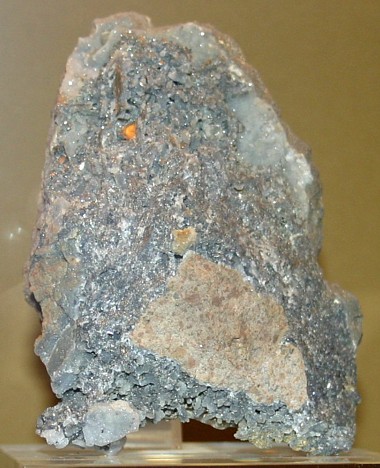|
.
Sylvanite
Mineral Facts:
Chemical Formula: (Au,Ag)Te2;
24% gold; 13% silver
Sylvanite
is a telluride of gold and silver.
Colors:
Metallic Silver white. Streak is
gray.
Hardness: 1.5 to 2
Density:
8 to 8.2
Cleavage:
One perfect cleavage on 010.
Crystallography:
Monoclinic
Distinct crystals rare. Structure. Usually bladed or granular. Often in
skeleton forms deposited on rock surfaces and resembling writing in
appearance.
Luster:.
Brilliant Metallic luster
Optics:
(Refractive Index) = 1.63
|
 |
|
Composition, Structure and
Associated Minerals:
Sylvanite is silver-white or
steel-gray and has a brilliant metallic luster and a yellowish gray streak.
Sylvanite is more common than calaverite. It is an isomorphous mixture of
gold and silver tellurides in the ratio of about 1 to 1. It
occurs in
veins with
native gold,
quartz,
fluorite,
dolomite, and various
sulfides and other tellurides.
Though not widespread, it is a locally important ore of gold. In crystallization
sylvanite is isomorphous
with
calaverite. Its crystals are usually rich in planes, about 75 having been
identified. Their habit
is usually tabular. The mineral also
occurs in skeleton crystals and in aggregates that
are platy or granular. Twinning is common. Many twinned aggregates form networks suggesting
writing, hence the name "Schrifterz" often applied to the mineral by the
Germans.
Identification
and Diagnostics
Sylvanite is easily fusible
with a blow pipe at (1). If a
little of the powdered mineral is heated in concentrated sulphuric acid the
solution assumes a deep red color (an indication of tellurium). When decomposed in nitric
acid leaves a rusty-colored, spongy mass of gold, and the solution with
hydrochloric acid gives white precipitate of
silver chloride. When
heated with sodium
carbonate on charcoal it gives a globule of gold and silver.
Sylvanite is determined, by
the above tests, by its silver color and good cleavage.
Its chemical properties are the
same as those of calaverite, but the silver precipitate produced by adding
HC1
to its solution in
HNO3
is
always large. It is
best distinguished from the gold telluride by its cleavage and from Petzite
((Ag,Au)2Te) and kessite (Ag2Te) by its crystallization, and by the yellow
metallic globule produced when the mineral is roasted on charcoal. It is
distinguishable from krennerite by its crystallization.
Occurrence,
Localities and Origins:
Localities and Origin. Sylvanite
is a rare mineral, and is found with gold ores and the other tellurides in veins at Offenbanya and Nagyag in
Romania, in the mines at Cripple Creek and in Boulder Co., Colorado, near Kalgoorlie, Western
Australia, in small quantities
near Balmoral in the Black Hills, S.D., and at
Moss, near Thunder Bay, Ontario. Like calaverite it was deposited by
ascending
magmatic waters, or by hot vapors. It is mined with calaverite
as a gold and silver ore at Cripple Creek and in Boulder Co., Colorado. The
name is derived from Transylvania
(now Romania),
where it was first found. Its main use is as an ore of gold.
.Return
to the
Mineral Collectors Information Page |
|


